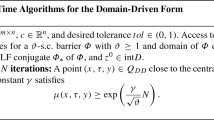Abstract
Detecting infeasibility in conic optimization and providing certificates for infeasibility pose a bigger challenge than in the linear case due to the lack of strong duality. In this paper we generalize the approximate Farkas lemma of Todd and Ye (Math Program 81:1–22, 1998) from the linear to the general conic setting, and use it to propose stopping criteria for interior point algorithms using self-dual embedding. The new criteria can identify if the solutions have large norm, thus they give an indication of infeasibility. The modified algorithms enjoy the same complexity bounds as the original ones, without assuming that the problem is feasible. Issues about the practical application of the criteria are also discussed.
Similar content being viewed by others
References
Ben-Tal, A., Nemirovski, A.: Lectures on Modern Convex Optimization: Analysis, Algorithms, and Engineering Applications. MPS-SIAM Series on Optimization. SIAM, Philadelphia (2001)
Borchers B.: SDPLIB 1.2, a library of semidefinite programming test problems. Optim. Methods Softw. 11(1), 683–690 (1999)
Güler O., Tunçel L.: Characterization of the barrier parameter of homogeneous convex cones. Math. Program. 81, 55–76 (1998)
de Klerk, E., Roos, C., Terlaky, T.: Infeasible-start semidefinite programming algorithms via self-dual embeddings. In: Pardalos, P., Wolkowicz, H. (eds.) Topics in Semidefinite and Interior Point Methods, Fields Institute Communications, vol. 18, pp. 215–236. AMS, Providence (1998)
Luo, Z.Q., Sturn, J.F., Zhang, S.: Duality and self-duality for conic convex programming. Report 9620/A, Econometric Institute, Erasmus University, The Netherlands (1996)
Luo, Z.Q., Sturn, J.F., Zhang, S.: Duality results for conic convex programming. Report 9719/A, Econometric Institute, Erasmus University, The Netherlands (1997)
Luo Z.Q., Sturn J.F., Zhang S.: Conic convex programming and self-dual embedding. Optim. Methods Softw. 14, 169–218 (2000)
Nesterov Y., Nemirovski A.: Interior-Point Polynomial Algorithms in Convex Programming. SIAM, Philadelphia (1994)
Pataki, G., Schmieta, S.: The DIMACS library of semidefinite-quadratic-linear programs. Preliminary draft, Columbia University, Computational Optimization Research Center (2002)
Renegar, J.: A Mathematical View of Interior-Point Methods in Convex Optimization. MPS/SIAM series on optimization. SIAM, Philadelphia (2001)
Sturm, J.F.: Primal–dual interior point approach to semidefinite programming. Ph.D. thesis, Tinbergen Institute Research Series, vol. 156, Erasmus University (1997)
Todd M.J., Ye Y.: Approximate Farkas lemmas and stopping rules for iterative infeasible-point algorithms for linear programming. Math. Program. 81, 1–22 (1998)
Author information
Authors and Affiliations
Corresponding author
Additional information
The authors were supported by the Canada Research Chairs program, NSERC Discovery Grant #5-48923 and MITACS.
Rights and permissions
About this article
Cite this article
Pólik, I., Terlaky, T. New stopping criteria for detecting infeasibility in conic optimization. Optim Lett 3, 187–198 (2009). https://doi.org/10.1007/s11590-008-0100-y
Received:
Accepted:
Published:
Issue Date:
DOI: https://doi.org/10.1007/s11590-008-0100-y



